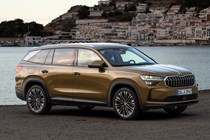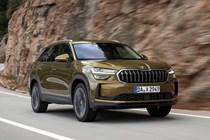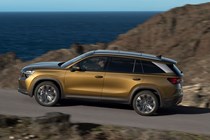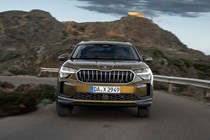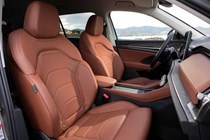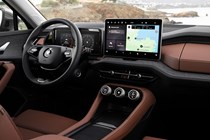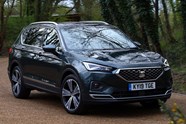
Skoda Kodiaq review
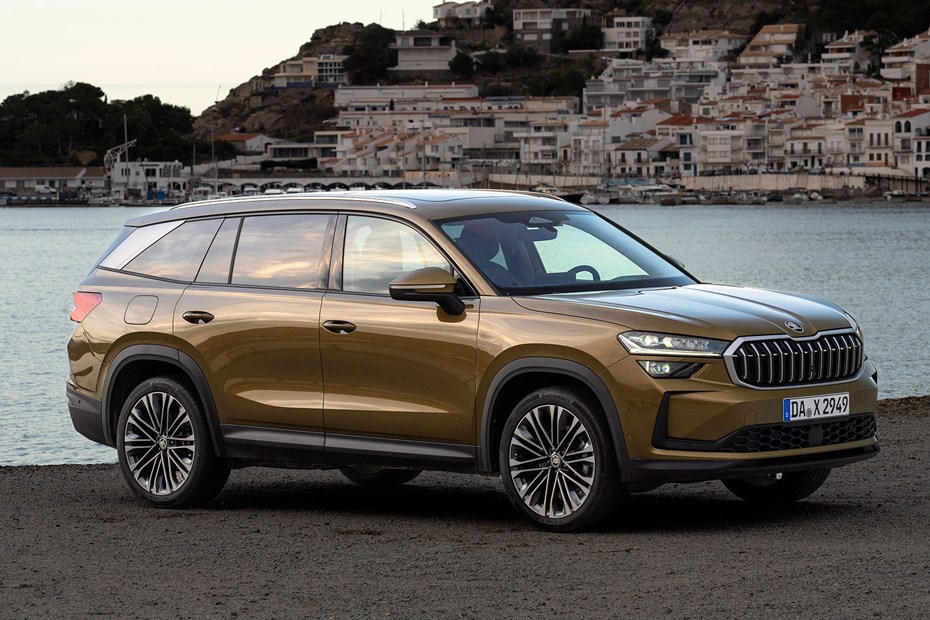
At a glance
| Price new | £36,330 - £45,490 |
|---|---|
| Road tax cost | £190 - £600 |
Get an insurance quote with

|
|
| Fuel economy | 42.8 - 53.2 mpg |
| Miles per pound | 5.5 - 7.0 |
| View full specs for a specific version | |
Available fuel types
Petrol
Diesel
Pros & cons
- Stylish and user-friendly cabin
- Vast room in the back
- Hushed ambience and smooth ride
- Longer than the Mk1
- No driving thrills
- Some truly horrible wheel options
Skoda Kodiaq SUV rivals
Overview
The Kodiaq has been a huge success for Skoda. Since the SUV was first launched in 2016, the Czech brand has sold more than 860,000 units – and it’s done so well because it’s always been a keenly priced large family car, available with either five or seven seats. It shares many of its qualities with the Superb estate, being easy to live with, while also offering brilliant room in the back and decent road manners.
This new Kodiaq is longer and roomier than the old one, for passengers and luggage alike. It has also some significantly new elements in the cabin, with a greater emphasis on sustainability. Plus, there’s a revised engine line-up. However, it’s worth noting that if you want a Skoda SUV with EV propulsion, you’ll still be shopping for an Enyaq.
Key cosmetic differences include new lights, a new logo and a new grille with some fresh air intakes underneath. There’s also a racier spoiler sticking out the back of the lengthened roof, and some new colours. The model change is rounded off with some brand spanking new alloy, sized from 18 to 20 inches, some of them with rather challenging designs.
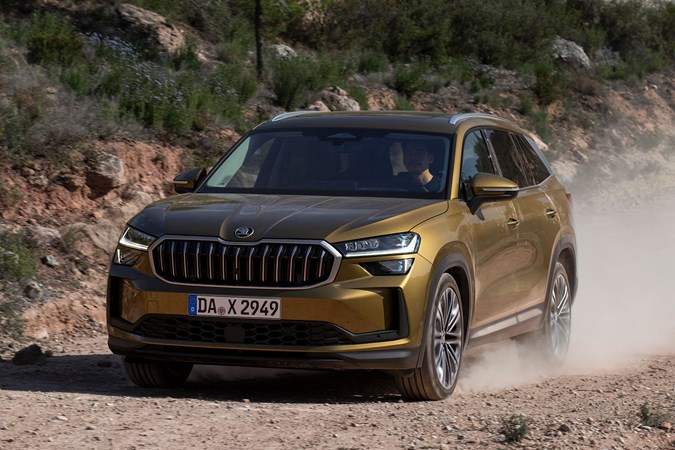
The Kodiaq still relies heavily on technology from parent company Volkswagen, but for many is a better package than anything offered by other VW Group brands. Essentially, this new model is more of the same and, as before, it succeeds in looking smart, modern, functional and stylish.
UK pricing for the Kodiaq starts at £36,645 and currently goes up to about £10k more than that, but there are some variants to follow with pricing not yet confirmed. Scroll down to find out how it stacks up against the competition – and whether Skoda has retained its title of king of the family SUVs.
What’s it like inside?
It’s a very successful mix of familiar and new, of traditional and advanced. There are elements from the Enyaq and the latest Superb, and nothing that feels like change for the sake of change.
It’s still very roomy – in fact slightly roomier than before, with an expanded boot and more headroom for those in the third row, while having a sleeker shape that has reduced aerodynamic drag.
If you go for seven seats you get less boot space than five-seaters, and if you go for the plug-in hybrid version you get less luggage capacity thanks to the addition of a big battery under the floor. But even the least capacious boot is still usefully roomy, and the largest is utterly cavernous. You get 910 litres with the second row in use, and 2,105 litres with them folded down, which is done with a simple flick of a lever.
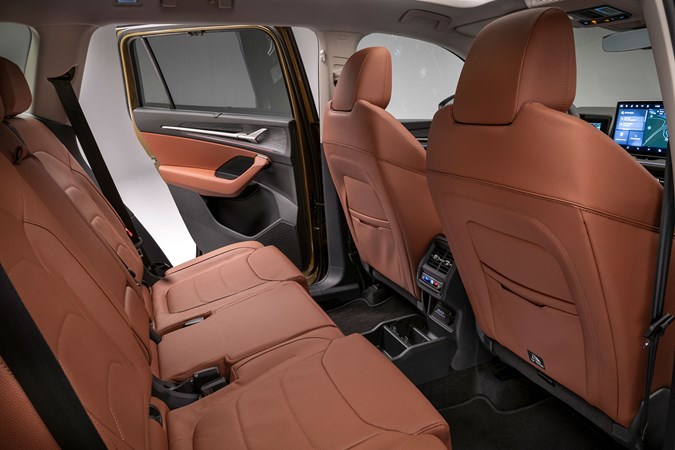
The passenger seats split 60:40, and can be slid forwards or back to allow you to balance more boot space against rear occupant legroom. But even with the front seats back and the back seats forwards, adults will be comfortable.
Rear passengers get heating controls and chargers plus a centre console with oddments space and two cupholders. Handily, this can be removed if an adult is going to sit in the middle seat.
Up front, the centre console is a masterclass in practicality. As the new Kodiaq is not available with a manual gearbox, the selector has been moved to the steering column. This has freed up lots of space which Skoda’s interior designers have made intelligent use of. There are up to four cupholders, depending how you choose to arrange it, plus wireless charging areas for two phones, a couple of C-USB ports and a lot of space in the armrest.
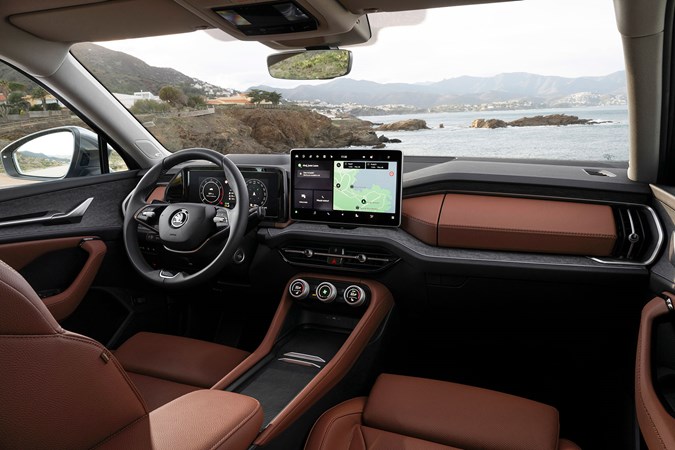
The dashboard now hosts a 13.0-inch central touchscreen, which is logically laid out and very configurable. Three physical multi-purpose dials sit below the screen, and, between them, they adjust everything from the driving modes (where fitted), to the volume and heating heating. It’s an intuitive, effective arrangement.
The steering wheel isn’t overburdened with controls, but those that are present are easy to operate without taking your eyes off the road.
The doors have useful removable rubbish bins for sweet wrappers and the like in their pockets, and slotted into the driver’s door itself is an umbrella – a familiar Skoda touch, along with an ice scraper clipped into the fuel filler cap. A new detail, along similarly user-friendly lines, is the cap on the screen wash reservoir under the bonnet. It opens up into a funnel that will reduce the amount of wasteful splashing.
Interior fabric choices include a material that is made of recycled plastic, which looks and feels very good in a way that defies its roots, and leather that is treated with coffee-bean waste, rather than chemicals, in the tanning process.
A head-up display is now available, and there’s the option of a big glass sunroof to bring a bright ambience to the cavernous cabin. Despite its size, it doesn’t sound boomy or creaky, thanks to a combination of effective sound-deadening and sturdy construction.
What it’s like to drive?
There are several engines to pick from: a 150hp mild hybrid 1.5-litre petrol four-cylinder, a 204hp 2.0-litre TSI (which is all-wheel-drive only), a 150bhp 2.0-litre diesel four and a 193hp version (the latter being only for all-wheel drive). Some models are available with DCC adaptive suspension, which when set in Sport mode adds a welcome firmness.
The PHEV is front-wheel drive and seats five only. It has a six-speed DSG automatic transmission, where the others all have seven speeds.
We’ve sampled four versions so far: two diesels, the mild hybrid and the plug-in hybrid. They weren’t in complete alignment with UK spec, but close enough for us to be pretty confident about their respective strengths and weaknesses.
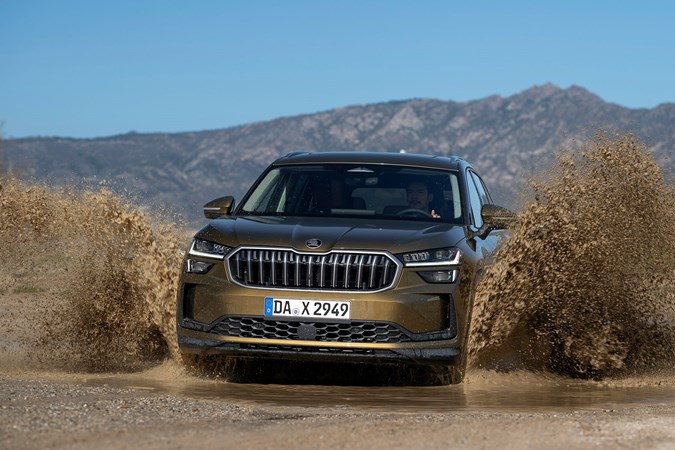
The mild hybrid, which we drove on a demanding route involving many hairpin bends and some fast motorway miles, returned an impressive real-world 35mpg. But as you might expect from a 150hp motor in such a big car, it doesn’t offer scorching performance. On those hills, it wasn’t exactly struggling but it certainly wasn’t shining. In more typical family driving, it’s smooth, lively enough and easygoing.
The plug-in hybrid is much perkier, reflected in a 0-62mph time that, at 8.4 seconds, is 1.3 seconds quicker. And if it replicates the official figures, it will top 60 miles of electric-only running thanks to its 25.7kWh battery, and recharge quickly. But a much longer drive will be needed to check that out.
Quite possibly the sweet spot in the range is the lesser of the two diesels, if you’re prepared to buck the current anti-diesel trend. In five-seat SE guise, it costs £38,945 and combines a 9.6-second 0-62mph time with economy around 50mpg. Its torquey nature makes it feel faster than that, and it’s untroubled by hills or heavy loads. The more powerful diesel is faster off the line, with a 7.8-second sprint time, but it’s thirstier, has a higher CO2 output, and currently only comes as a seven-seat 4×4 in SE L trim, which pushes the price to £56,225.
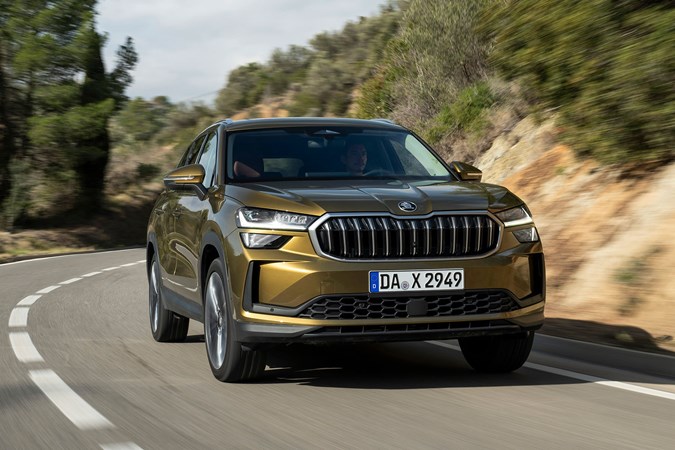
All this talk of performance is pretty much beside the point, though. The Kodiaq is not designed to be dynamically outstanding, and is at its best when it’s used for its core tasks of family holidays, the school run, shopping and taking vast quantities of garden waste to the tip.
Ride quality is good, but the body gets wobbly if you hammer it hard through the bends. And the steering is always a little vague and remote. That may change when the vRS version arrives, but for now the Kodiaq is going to bring at least as much pleasure to the passengers as to the driver.
What models and trims are available?
Initially there are two spec levels, SE and SE L. A Sportline model will be along soon, with marginally more visual pizzazz. And later there will be a vRS version.
SE comes with 18-inch wheels, front and rear LED lights, heated front seats and three-zone climate control, plus a bunch of safety-enhancing electronics, including some new arrivals: Turn Assist, Crossroad Assist and Collision Avoidance Assist.
SE L cars – priced from £40,205 – have 19-inch wheels as standard, adaptive matrix LED headlights, an electrically adjustable driver’s seat and electric boot opening. There are also various interior design packages available, called ‘selections,’ following the pattern established by the Enyaq.
What else should I know?
One of the Mk1 Kodiaq’s closest rivals was the seven-seat version of the Volkswagen Tiguan, the Tiguan Allspace. That’s now been discontinued, but we’re expecting it to be replaced in 2025 by a new VW SUV called the Tayron, already on sale in China. It’s a seven seater and has a plug-in hybrid option.
Meanwhile, a very good in-house option is still available: the SEAT Tarraco, currently priced from £33,450.



